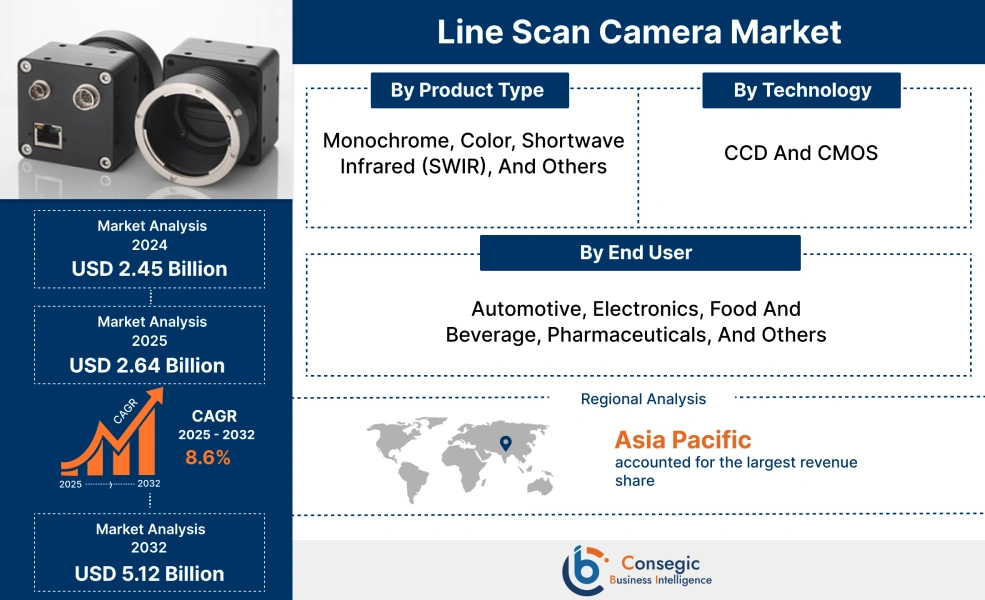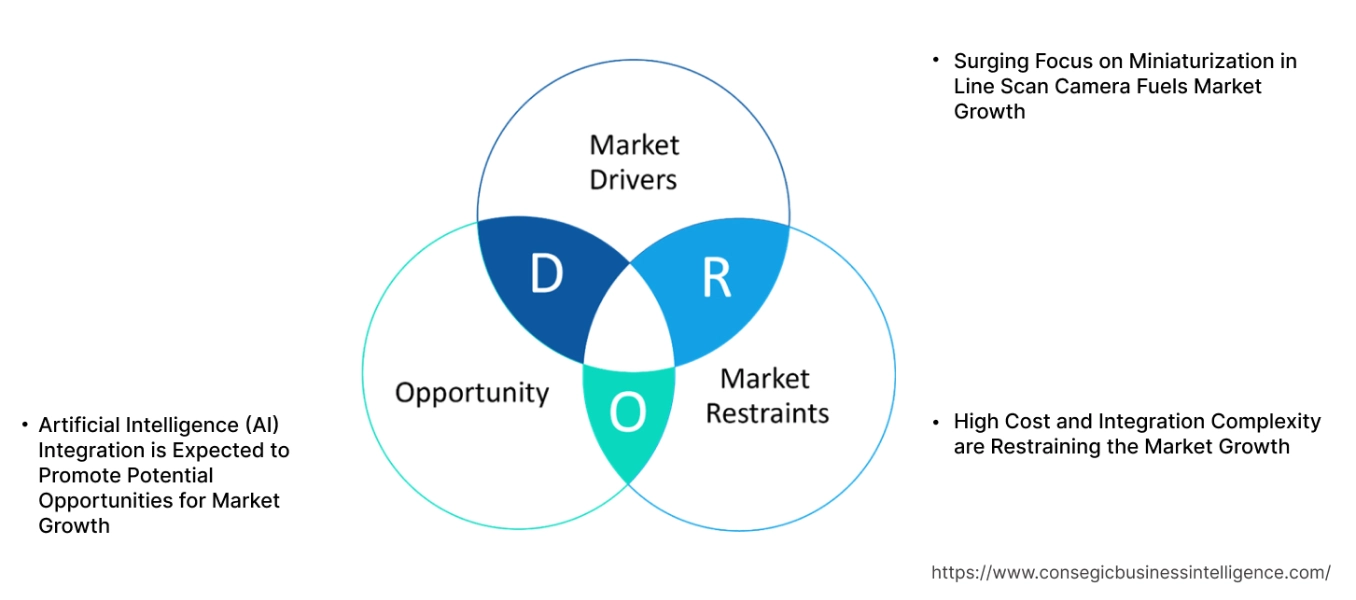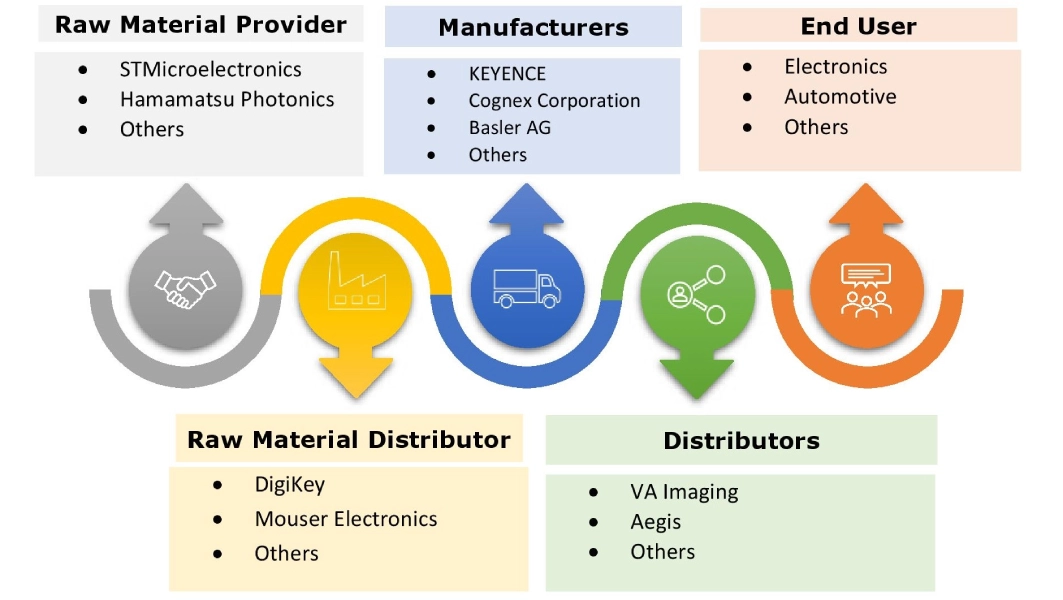Line Scan Camera Market Size:
Line Scan Camera Market size is estimated to reach over USD 5.12 Billion by 2032 from a value of USD 2.45 Billion in 2024 and is projected to grow by USD 2.64 Billion in 2025, growing at a CAGR of 8.6% from 2025 to 2032.
Line Scan Camera Market Scope & Overview:
A line scan camera has a single line of pixels that captures an image in one line at a time. The camera uses a long, narrow sensor with a single row of pixels to acquire data very quickly. Also, the cameras are associated with high-end applications where precision and speed are critical. Additionally, the key benefits and features include higher resolution, uniform illumination, high speed, and others which in turn is driving the line scan camera market growth. Moreover, the cameras are a powerful tool for applications that require continuous, high-resolution imaging of moving objects or large surfaces. The applications include industrial inspection, print inspection, web inspection, surface inspection, and others which in turn are boosting the line scan camera market demand. Furthermore, the growing need for smaller, more streamlined imaging solutions is driving the line scan camera industry.
How is AI Impacting the Line Scan Camera Market?
AI is significantly impacting the line scan camera market by enhancing capabilities in areas like defect detection, real-time analysis, and predictive maintenance within industrial automation and inspection systems. Also, AI-powered algorithms can analyze images from line scan cameras in real-time, identifying subtle defects or anomalies that might be missed by traditional methods. This is crucial for quality control in manufacturing and other industries. This integration is leading to more intelligent, efficient, and adaptable vision systems for various applications.
Line Scan Camera Market Dynamics - (DRO) :
Key Drivers:
Surging Focus on Miniaturization in Line Scan Camera Fuels Market Growth
The increasing focus on miniaturization of scan cameras due to growing applications with space constraints and high-performance demands is boosting the line scan camera market growth. Additionally, miniaturization helps to increase applications, improve performance, and cost-effectiveness driving the line scan camera market demand. Further, the rising need for compact devices for Quality control, defect detection, and inspection in industries such as electronics and automotive is driving the market progress.
- For instance, in June 2024, Teledyne DALSA launched Linea Lite which is an 8k Super Resolution camera. The compact and cost-effective GigE line scanner delivers 8k resolution images, with high is driving the market progress.
Therefore, the increasing focus on miniaturization is driving the adoption of cameras in various industries, in turn proliferating the growth of the market.
Key Restraints:
High Cost and Integration Complexity are Restraining the Market Growth
The integration complexity of scan cameras into the system requires complex hardware and software, including precise motion control, specialized lighting, and synchronization mechanisms which in turn is hindering the line scan camera market expansion. Further, the increased complexity and specialized components incur huge overall system costs as compared to area scan cameras which in turn is restraining the market expansion.
Therefore, the increased complexity and high cost of specialized components are hindering the line scan camera market expansion.
Future Opportunities :
Artificial Intelligence (AI) Integration is Expected to Promote Potential Opportunities for Market Growth
The integration of artificial intelligence with line scan cameras enables advanced features like real-time defect detection, image processing, and automated analysis which in turn is propelling the line scan camera market opportunities. Additionally, the integration is essential for industries requiring high-speed and high-resolution imaging solutions. Further, the key benefits of integration include enhanced defect detection, real-time analysis, automated inspection, and others which in turn is boosting the market evolution.
- For instance, in February 2025, Elementary launched Vision Link which is a software compatible with line scan, microscope, X-ray, and area scan models. The software enables AI capabilities into the models bridging the gap between legacy systems and advanced AI technology.
Hence, the integration of AI into imaging solutions is anticipated to increase the utilization in turn promoting prospects for line scan camera market opportunities during the forecast period.
Line Scan Camera Market Segmental Analysis :
By Product Type:
Based on the product type, the market is segmented into monochrome, color, shortwave infrared (SWIR), and others.
Trends in the Product Type:
- Monochrome cameras offer higher output resolution and sensitivity compared to color cameras driving applications in high-speed imaging in low-light conditions which in turn is fueling the line scan camera market trends.
- The proliferation of Industry 4.0 is driving the demand for the adoption of the shortwave infrared (SWIR) segment for quality control, material sorting, and surveillance which in turn is fueling the line scan camera market trends.
Monochrome segment accounted for the largest revenue share of 46.67% in the year 2024.
- A monochrome imaging system is a specialized type of camera that captures images in black and white, or grayscale and provides an excellent combination of high resolution and fast scan rates.
- Additionally, the monochrome segment's key benefits include speed, sensitivity, and cost-effectiveness which in turn are boosting the line scan camera market size.
- Further, the integration of AI and machine learning for enhanced image analysis in the monochrome segment is propelling the line scan camera market size.
- Thus, according to the line scan camera market analysis, the integration of AI and machine learning is driving the market trends.
The color segment is anticipated to register the fastest CAGR during the forecast period.
- The color segment is majorly utilized in color imaging applications such as recycling, sorting, transportation, food, and web inspection.
- Additionally, advancements in technology such as compact designs and AI-powered solutions are propelling the adoption of the color segment which in turn is propelling the line scan camera market share.
- Further, the increasing adoption in industries such as manufacturing, packaging, and automation is driving the adoption of the color segment which in turn is boosting the line scan camera market share.
- For instance, in July 2024, Teledyne DALSA announced the launch of color modules of the AxCIS family which is a high-resolution fully integrated scan imaging module. Also, the color modules offer low-cost inspection for machine vision applications including battery and print inspection.
- Therefore, according to the line scan camera market analysis, increasing adoption in industries such as manufacturing, packaging, and automation is anticipated to boost the market during the forecast period.
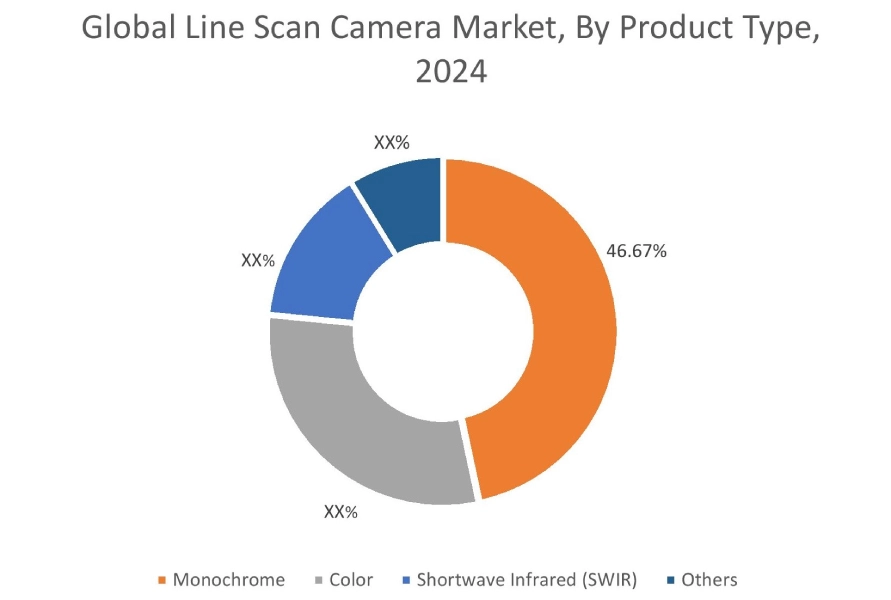
By Technology:
Based on the Technology, the market is bifurcated into CCD and CMOS.
Trends in the Technology:
- The CMOS sensors are gaining traction in machine vision due to their speed and cost-effectiveness which in turn is driving the market trends.
- The trend towards demand for high sensitivity and low noise is driving the adoption of CCD sensors.
CMOS segment accounted for the largest revenue share in the year 2024 and is anticipated to register the fastest CAGR during the forecast period.
- CMOS (Complementary Metal-Oxide-Semiconductor) sensors are commonly used in line scanners to capture images.
- Additionally, the key advantages of CMOS sensors include high speed, resolution, dynamic performance, low power consumption, and improved noise and quantum efficiency.
- Further, the low heat generation of CMOS sensors allows for more compact camera designs and reduces infrastructure needs which in turn is driving the adoption of CMOS sensors.
- For instance, in October 2024, JAI launched two new high-speed CMOS line scanner including SW-16000TL-CXP4A color model and SW-16000M-CXP4A monochrome model. The models offer 16K resolution delivering high data throughput, high-speed connectivity making them ideal for manufacturing processes that require detailed vision inspection of small features at high speeds.
- Thus, as per the market analysis, the aforementioned advantages are driving the adoption of CMOS sensors.
By End User:
Based on the end user, the market is segmented into automotive, electronics, food and beverage, pharmaceuticals, and others.
Trends in the End User:
- The diverse range of end-users and the continuous advancements in imaging technology are driving the growth of the market across various industries.
- The ability to ensure the quality and safety of food and beverage products is critical for maintaining consumer trust and meeting regulatory standards is driving the market adoption in the food and beverages sector.
The electronics segment accounted for the largest revenue in the year 2024.
- The electronics industry benefits from the precision and high-speed capabilities of line scan cameras.
- These cameras are used in the inspection of printed circuit boards (PCBs), semiconductor wafers, and other electronic components, where even the smallest defect can lead to significant operational failures.
- As the demand for smaller, more powerful electronic devices grows, the need for detailed and accurate inspection solutions becomes paramount. Line scanners meet this need by providing the high-resolution imaging necessary to ensure defect-free manufacturing.
- Thus, as per the market analysis, the need for smaller and more powerful electronic devices is driving the adoption of scan cameras by the electronic sector.
The automotive segment is anticipated to register the fastest CAGR during the forecast period.
- In the automotive sector, line scanners are extensively used for quality assurance and inspection processes. As manufacturers strive to meet stringent safety and quality standards, the ability of these cameras to detect minute defects and inconsistencies in components has become vital.
- These cameras are used to inspect automotive components and systems for defects and ensure they meet quality standards.
- The ability to capture detailed images and detect minute defects at high speeds makes line scan cameras essential in automated manufacturing systems in the automotive sector.
- The increasing adoption of electric and autonomous vehicles is further driving the market demand in the automotive sector.
- Therefore, the increasing adoption of electric and autonomous vehicles is anticipated to boost the market during the forecast period.
Regional Analysis:
The regions covered are North America, Europe, Asia Pacific, Middle East and Africa, and Latin America.
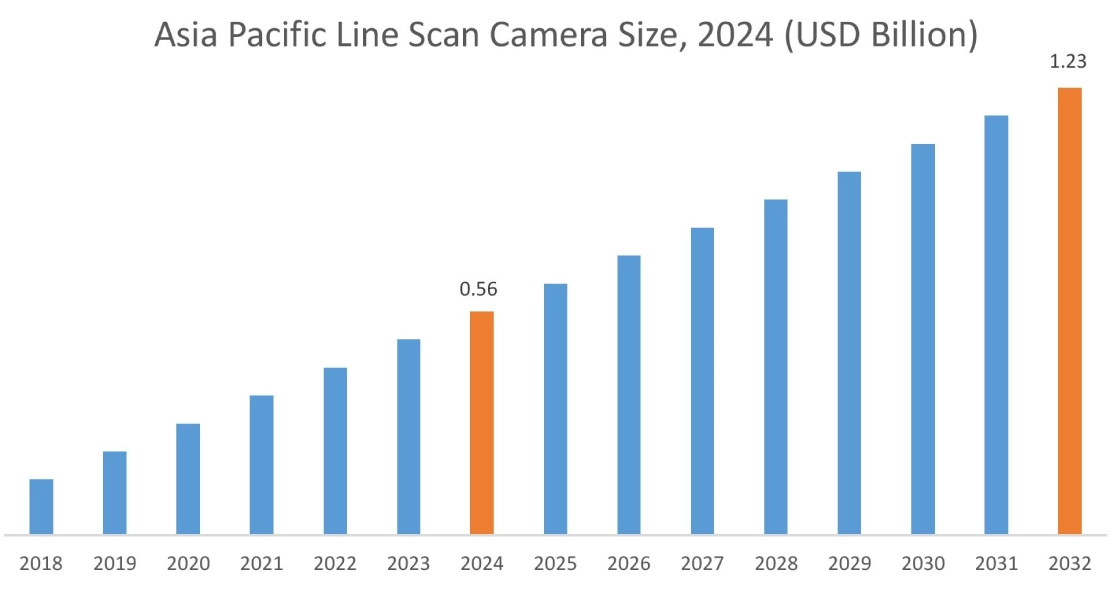
Asia Pacific region was valued at USD 0.56 Billion in 2024. Moreover, it is projected to grow by USD 0.60 Billion in 2025 and reach over USD 1.23 Billion by 2032. Out of this, China accounted for the maximum revenue share of 36.34%. The region represents a growing market, driven by strong needs from key industries such as automotive, electronics, and manufacturing. Countries in the region are leading the charge, with robust industrial bases and a high propensity for adopting advanced technologies. Further, the favorable government initiatives promoting industrial automation and the presence of key market players in the region are significant factors contributing to the market's evolution in the region.
- For instance, KEYENCE offers line scan vision systems capable of linking with up to four-line scanners. This allows for comprehensive inspection of moving webs and cylindrical objects. These systems can capture images with a resolution of up to 67 megapixels, enabling them to identify even the tiniest features and defects.
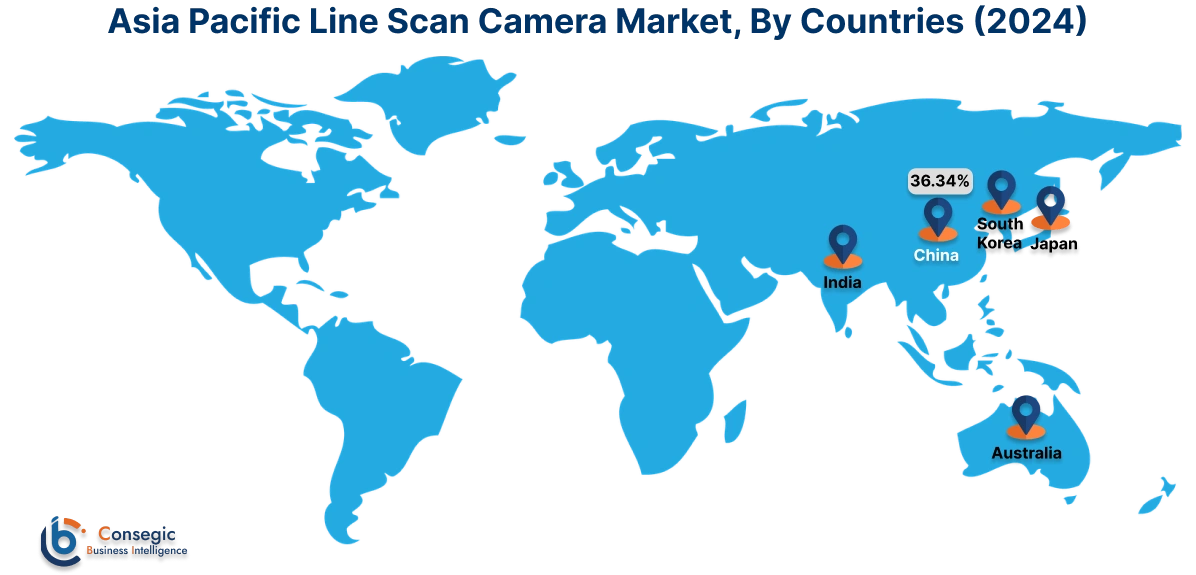
North America is estimated to reach over USD 1.88 Billion by 2032 from a value of USD 0.90 Billion in 2024 and is projected to grow by USD 0.97 Billion in 2025. The region's strong focus on quality control and regulatory compliance in industries such as automotive, pharmaceuticals, and food and beverage are fueling the need for line scanner cameras in the region. The United States, being a major hub for technological innovation, is at the forefront of adopting advanced imaging solutions. Further, the increasing investments in research and development activities and the presence of leading market players are expected to drive market growth in North America.
- For instance, Cognex Corporation offers In-Sight 3800 with high-resolution features. The camera is designed for industrial manufacturing applications. This system uses advanced AI and super-fast processing to find even the tiniest details and flaws, all while keeping up with production line speeds.
Additionally, according to the analysis, in Europe the automotive and electronics industries in this region are major users of line scanner cameras, relying on them for quality control and inspection. Europe's commitment to sustainability and innovation further drives the adoption of these advanced imaging technologies, boosting market evolution. Additionally, the stringent regulatory requirements and the focus on maintaining high-quality standards in manufacturing processes are driving the need for line scanner cameras in Latin America.
Further, the evolution from traditional CCD (Charge-Coupled Device) technology to CMOS (Complementary Metal-Oxide-Semiconductor) has allowed for a more efficient, cost-effective, and versatile line scanner camera. These advancements have not only improved the performance and functionality of the cameras but have also expanded their application scope in the Middle East & Africa region.
Top Key Players and Market Share Insights:
The global line scan camera market is highly competitive with major players providing camera to the national and international markets. Key players are adopting several strategies in research and development (R&D), product innovation, and end user launches to hold a strong position in the line scan camera industry. Key players in the line scan camera market include-
- KEYENCE (Japan)
- Cognex Corporation (USA)
- Micro-Epsilon (Germany)
- Vision Components GmbH (Germany)
- JAI A/S (Denmark)
- Basler AG (Germany)
- HIK Vision (China)
- Dahua Technology Co. Ltd (China)
- Sony Corporation (Japan)
- Omron Corporation (Japan)
Recent Industry Developments :
Product Launches:
- In July 2024, Basler unveiled the initial models in its new line scanner camera series, the Racer 2 L 8k and 16k. These cameras feature the latest Gpixel sensors and a CXP-12 interface, offering resolutions of 8,000 or 16,000 pixels with line rates reaching up to 200 kHz. When paired with Basler frame grabbers and VisualApplets software for FPGA programming, a pre-processing solution becomes available that substantially reduces the CPU workload in the application.
Line Scan Camera Market Report Insights :
| Report Attributes | Report Details |
| Study Timeline | 2019-2032 |
| Market Size in 2032 | USD 5.12 Billion |
| CAGR (2025-2032) | 8.6% |
| By Product Type |
|
| By Technology |
|
| By End User |
|
| By Region |
|
| Key Players |
|
| North America | U.S. Canada Mexico |
| Europe | U.K. Germany France Spain Italy Russia Benelux Rest of Europe |
| APAC | China South Korea Japan India Australia ASEAN Rest of Asia-Pacific |
| Middle East and Africa | GCC Turkey South Africa Rest of MEA |
| LATAM | Brazil Argentina Chile Rest of LATAM |
| Report Coverage |
|
Key Questions Answered in the Report
Which segmentation details are covered in the line scan camera report? +
The line scan camera report includes specific segmentation details for product type, technology, end user, and regions.
How big is the line scan camera market? +
The line scan camera market size is estimated to reach over USD 5.12 billion by 2032 from a value of USD 2.45 billion in 2024 and is projected to grow by USD 2.64 billion in 2025, growing at a CAGR of 8.6% from 2025 to 2032.
Which is the fastest segment anticipated to impact the market growth? +
In the line scan camera market, the color segment is the fastest-growing segment during the forecast period due to increasing adoption in industries such as manufacturing, packaging, and automation.
Who are the major players in the line scan camera market? +
The key participants in the line scan camera market are KEYENCE (Japan), Cognex Corporation (USA), Basler AG (Germany), HIK Vision (China), Dahua Technology Co. Ltd (China), Sony Corporation (Japan), Omron Corporation (Japan), Micro-Epsilon (Germany), Vision Components GmbH (Germany), JAI A/S (Denmark), and others.
What are the key trends in the line scan camera market? +
The line scan camera market is being shaped by several key trends including the proliferation of Industry 4.0 is driving the demand for the adoption of shortwave infrared (SWIR) as well as increasing focus on food safety and quality control and others.
